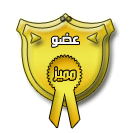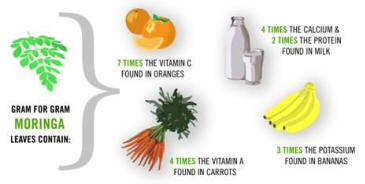شجرة المورينقا (( الروّاق)) Moringa OLeifera
صفحة 1 من اصل 1
 شجرة المورينقا (( الروّاق)) Moringa OLeifera
شجرة المورينقا (( الروّاق)) Moringa OLeifera
شجرة المورينقا (( الروّاق))

تعرف بالحبة الغالية/ الشجرة الكنز/ الشجرة المعجزة/ شجرة اليسار/الثوم البري/ فجل الحصان/ وعصا الطبلة.
اسمها العلميMoringa OLeifera وهي عبارة عن أشجار وشجيرات تنتمي إلى العائلة Moringaceae ومصدر الاسم يأتي من اللغة التاميلية. أما موطن الشجرة الأصلي فهو شمال الهند على سفوح جبال الهملايا.
كما تنتشر في باكستان, بنغلاديش وأفغانستان. هذا وتزرع الشجرة على نطاق واسع في العديد من المناطق المدارية والتي تشمل السودان وأثيوبيا والفلبين, كما انتشرت في أمريكا الجنوبية وجنوب أفريقيا.
استخدم قدماء الرومان والإغريق والمصريون شجرة المورينقا في العديد من الوصفات الطبية,
وتعتبر أشجار المورينقا من أنواع الأشجار متساقطة الأوراق, سريعة النمو, صغيرة إلى متوسطة الحجم, ارتفاعها من 7 أمتار – 15 متراً, ذات سيقان قائمة منتشرة القمة, ريشية الأوراق بيضاوية مقلوبة خضراء باهتة - ثمارها ذات قرون طويلة ومثلثة المقطع. تنمو الشجرة في الأراضي الطينية الخفيفة جيدة الصرف وتتحمل الجفاف بدرجة عالية - ولا تتحمل الشجرة الصقيع والجليد.
تتكاثر الشجرة بالبذور أو العقل و تحتوي بذور ها على 30% زيت, منه 65% حامض الأوليك . يستعمل الزيت في تشغيل الماكينات مثل زيت نبات الجاتروفا وهو غير سام ويستخدم في الطعام.
استخدامات المورينقا:-
- تستخدم الأجزاء المختلفة كغذاء للإنسان حيث تؤكل الأوراق والأفرع الصغيرة والقرون الصغيرة والأزهار والجذور.
وتعتبر الأوراق أكثر مايستهلك من الشجرة كغذاء حيث تحتوي على قليل من الزيوت والكاربوهيدرويتات وهي غنية بالمعادن والفايتمينات والأحماض الأمينية. كما تستهلك الأزهار والقرون مطبوخة . على صعيد آخر يمكن استهلاك البذور المطبوخة مثل البسلة. أما الجذور فيمكن استخدامها في الأكل بعد نزع قشرتها الخارجية لأنها تحتوي على مواد ضارة , كما يوصي بأن لايكثر الإنسان من تناول الجذور لنفس السبب.
- تصلح الأوراق والأفرع الصغيرة كغذاء لكل حيوانات المزرعة والدواجن ,خاصة إذا ماخلط بالبرسيم بنسبة 70% مورينقا و10% برسيم و20% أي علف آخر.
- تستخدم بدرة بذور المورينقا في تصفية الماء العكر بطريقة سريعة وفعالة وآمنة تضمن صفاء الماء وإزالة الكثير من الملوثات البكتيرية.
- تستخدم أوراق وأزهار وقرون وبذور شجرة المورينقا في العلاج البديل لعديد من الأمراض أهمها : سوء التغذية وقرحة المعدة والاسهالات كما تستخدم في علاج الالتهابات الجلدية البكتيرية والفطرية.
- هنالك العديد من الاستخدامات الأخرى منها: استخدامها كمبيد طبيعي لمكافحة مرض ذبول البادرات في المشتل وكسماد طبيعي . كما يستخدم غلف الأشجار في دباغة الجلود.



Family • Moringaceae
Malungay
Moringa oleifera Linn.
BEN OIL TREE
La mu
Other scientific names Common names
Moringa oleifera Linn. Arunggai (Pang.)
Moringa nux-ben Perr. Balungai (P. Bis.)
Moringa pterygosperma Gaertn. Dool (Bik.)
Guilandina moringa Linn. Kamalongan (P. Bis.)
Kalamungai (C. Bis.)
Kalungai (Bik., Bis., Tag.)
Kalunggay (Bik.)
Kamalungai (Pamp., Tag.)
Komkompilan (Ilk.)
Molongai (Tag.)
Malungay (Tag.)
Malunggue (Pamp.)
Malungit (Pamp., Bis.)
Maroñgoi (Sbl.)
Maruñgaai (Ilk., Ibn.)
Drumstick tree (Engl.)
Horse-radish tree (Engl.)
La mu (Chin.)
Ben oil tree (Engl.)
Botany
Malungai is a small tree growing as high as 9 meters, with a soft and white wood and corky and gummy bark. Leaves are alternate, usually thrice pinnate, 25 to 50 centimeters long. Each compound leaf contains 3-9 very thin leaflets dispersed on a compound (3 times pinnate) stalk. The leaflets are thin, ovate to elliptic, and 1 to 2 centimeters long. Flowers are white and fragrant, 1.5 to 2 centimeters long, on spreading panicles. Pod is 15 to 30 centimeters long, pendulous, three-angled, and nine-ribbled. Seeds are three-angled, and winged on the angles.
Distribution
• Planted throughout the Philippines in settled areas at low and medium altitudes.
• Introduced from Malaya or some other part of tropical Asia in prehistoric times.
• A common backyard vegetable and a border plant.
• Now pantropic.
Propagation
• Propagation by seeds and stem cuttings.
• Mature malunggay cuttings should be 2 cm or more in diameter and not less than 80 cm (30 inches) in length. Mature cuttings are preferred as they sprout earlier and grow faster.
• The only pests known to attack malunggay are mites of the Tetranychus spp.
Parts utilized
Flowers, leaves, young pods
Properties
• Root has the taste of horseradish.
• Considered galactagogue, rubefacient, antiscorbutic, diuretic, stimulant, purgative, antibiotic, antifungal.
• Antiinflammatory, antitumor activities on mice studies.
• Antioxidant, anti-aging, anti-ulcer.
• Estrogenic, antiprogestational, hypoglycemic, antihyperthyroidism, hypocholesterolemic, antihyperthyroid, antispasmodic.
• Considered abortifacient and emmenagogue.
• Purported to be beneficial for decreasing blood pressure, relieving headaches and migraines, reducing inflammatory and arthritic pains, anti-ulcer, anti-tumor. Purported to be beneficial for decreasing blood pressure, relieving headaches and migraines, reducing inflammatory and arthritic pains.
Constituents
• Root yields a essential oil, pungent and offensive in odor.
• Seed contains traces of an acrid and pungent alkaloid, Ben of Behen oil, whhich contains palmitic, stearic, myristic, oleic, and behenic acids, phytosterin; two alkaloids the mixture of which has the same action as epinephrine.
• Bark exudes a reddish gum with the properties of tragacanth, which is utilized for tanning.
• Gum yields bassorin, dextrin, enzyme myrosin and emulsin. The astringency of the gum is attributed to the presence of moringo-tannic acid
• Studies of MO leaves have yielded phytochemicals to which are attributed hypotensive effects and anti-cancer properties. The root bark has sex hormone-related properties.
• Root bark contains alkaloids, moringine which is similar to benzylamine, and moringinine; traces of essential oil, phytosterol, waxes and resins. Also contains a rich combination of zeatin, quercetin, beta-sitosterol, caffeoylquinic acid, pterygospermin and kaemferol.
Uses
Nutritional
• Flowers, young leaves and young pods eaten as a vegetable inn the Philippines, Malaya, and India.
• In Malaya, seeds also eaten as peanuts.
• Roots are used as seasoning because of it horseradish flavor.
• Young leaves are a rich source of calcium, iron, phosphorus and vitamins A, B and C.
• High in HDL (high density lipoproteins); a source of amino acids, omega oils, antioxidants.
• Young fruit yield a high amount of protein and phosphorus, a fair source of calcium and iron,
• Comparative content: Gram for gram, 7 times the vitamin C in oranges, 4 times the calcium and twice the protein in milk, 4 times the vitamin A in carrots, 3 times the potassium in bananas.
• 100 gms or 1 cup of cooked malunggay leaves contain 3.1 g protein, 0.6 g fiber, 96 mg calcium, 29 mg phosphorus, 1.7 mg iron, 2,820 mg beta-carotene, 0.07 mg thiamin, 0.14a mg riboflavin, 1.1 mg niacin, and 53 mg of vitamin C. (Dr. Lydia Marero of the Food and Drug Research Institute -FNRI)
Folkloric
- Decoction of leaves used for hiccups, asthma, gout, back pain, rheumatism, wounds and sores.
- Young leaves, usually boiled, used to increase the flow of breast milk.
- Pods for intestinal parasitism.
- Leaves and fruit used for constipation.
- Decoction of boiled roots used to wash sores and ulcers.
- Decoction of the bark used for excitement, restlessness.
- In India pounded roots used as poultice for inflammatory swelling. Flowers used for catarrh, with young leaves or young pods.
- In Nicaragua decoction of roots used for dropsy.
- Roots have been used as abortifacient. In India, bark is used as abortifacient.
- Decoction of root-bark used as fomentation to relieve spasms; also, for calculous affections.
- Gum, mixed with sesamum oil, used for relief of earaches. Same, also reported as abortifacient.
- In Java, gum used for intestinal complaints.
- Roots chewed and applied to snake bites.
- Decoction of roots is considered antiscorbutic; also used in delirious patients.
- Juice of roots is used for otalgia.
- Bark used as rubefacient remedy.
- Decoction of roots is use as gargle for hoarseness and sore throat.
- Leaves used as purgative.
- Chewing of leaves used in gonorrhea to increase urine flow.
- Fresh roots used as stimulant and diuretic.
- Seeds for hypertension, gout, asthma, hiccups, and as a diuretic.
- Rheumatic complaints: Decoction of seeds; or, powdered roasted seeds applied to affected area.
- Juice of the root with milk used for asthma, hiccups, gout, lumbago.
- Poultice of leaves applied for glandular swelling.
- Pounded fresh leaves mixed with coconut oil applied to wounds and cuts.
- The flowers boiled with soy milk thought to have aphrodisiac quality.
- Root is rubefacient and plaster applied externally as counterirritant.
- In West Bengal, India, roots taken by women, esp prostitutes, for permanent contraception (Studies have shown total inactivation or suppression of the reproductive system).
Others
• Dye: In Jamaica the wood is used for dyeing blue color.
• Oil: known as ben oil, extracted from flowers can be used as illuminant, ointment base, and absorbent in the enfleurage process of extracting volatile oils from flowers. |With ointments, the oil allows longer shelf life without undergoing oxidation.The oil, applied locally, has also been helpful for arthritic pains, rheumatic and gouty joints.
Breastfeeding women
• Malunggay leaves and pods are helpful in increasing breast milk in the breastfeeding months. One tablespoon of leaf powder provide 14% of the protein, 40% of the calcium, 23% of the iron and most of the vitamin A needs of a child aged one to three. Six tablespoons of leaf powder will provide nearly all of the woman's daily iron and calcium needs during pregnancy and breastfeeding.
Studies
• Moringa preparations have been cited often in scientific literature as antibiotic, antiinflammatory, hypocholesterolemic and hypoglycemic. However, many of the reports are not placebo-controlled randomized clinical trials.
• Anti-Inflammatory / Anti-tumor: Anti-inflammtory and Antitumor Activities of Seeds Extracts of Malunggay—A study showed the crude ethanol extract of dried seeds inhibited the carrageenan-induced inflammation in the hind paw of mice by 85% at a dosage of 3 mg/g body weight; the mature green seeds by 77%. The crude ethanol extract also inhibited the formation of Epstein-Barr virus-early antigen (EBV-EA) induced by 12-0-tetradecanoylphorbol-13-acetate (TPA). At a dosage of 100 ?g/ml, the extract inhibited EBV-EA formation by 100% suggesting its antitumor-promoting activity.
• Ovarian Cancer: Possible Role of Moringa oleifera Lam. Root in Epithelial Ovarian Cancer: A hormonal etiology of epithelial ovarian cancer has been long suspected. Study suggests M Oleifera can interfere with hormone receptor-related and neoplastic growth-related cytokine pathways through centrally acting mechanisms.
• Asthma: Antiasthmatic activity of Moringa oleifera Lam: A clinical study: Study showed improvement in forced vital capacity, FEV1, and peak expiratory flow rate. It suggests a usefulness for MO seed kernel in patients with asthma.
• Antibiotic: 50 years ago, a study yielded Pterygospermin, a compound that readily dissociates into two molecules of benzyl isothiocyanate which has been shown to have antimicrobial properties. Unfortunately, many of the reports of antibiotic efficacy in humans were not from placebo controlled, randomized clinical trials. Recent studies have demonstrated possible efficacy against H. pylori.
• Hormonal properties / Abortifacient: Biochemical observations and histologic findings have been correlated with the anti-implantation action of aequous extracts, one possible explanation for its use as an abortifacient. source
• Antiurolithiatic: Study showed lowering of stone forming constituents in the kidneys of calculogenic rats with the use of aqueous and alcoholic extracts of MO suggesting antiurolithiatic activity.
• Antimicrobial / Water Purifyiing: Study of MO seeds paste for water purification yielded a steroidal glycoside, strophantidin, a bioactive agent in the seed. The seed paste was found effective in clarification and sedimentation of inorganic and organic matter in raw water, reducing total microbial and coliform counts by 55% and 65% respectively, in 24 hours, compared to alum with 65% and 83% reduction.
• Antipyretic / Wound Healing: Study of the ethanolic and ethyl acetate extracts of MO showed significant antipyretic activity in rats; the ethyl acetate extract of dried leaves showed significant wound healing on rat wound models.
• Analgeic: Previous studies have shown analgesic activity from the leaves of MO. This study on the alcoholic extract of MO seeds showed potent analgesic activity comparable to that of aspirin dose of 25 mg/kg BW.
• Hepatoprotective / Antioxidant: Study concluded that the alcoholic extracts of MO produced significant hepatoprotective and antioxidant activity, the aqueous extracts of the fruit less than the alcoholic extract.
• Anti-Ulcer: Study of M oleifera extract showed ulcer by protection by modulating 5-HT secretion through EC dell via 5-HT3 receptors in the gastrointestinal tract.
• Anthelmintic: In a comparative study of the anthelmintic activity of M oleifera and V negundo against Indian earthworm Pheritima posthuma, dose-dependent activity was observed with M oleifera showing more activity than V negundo.
• Comparison with Atenolol: Study comparing the effects of M oleifera with atenolol in adrenaline-induced rats on serum cholesterol, triglycerides, glucose level, heart and body weight showed the M oleifera leave extract made significant changes in each cardiovascular parameter.
• Hepatoprotective: Study in acetaminophen-induced liver disease in mice showed that leaves of MO can prevent hepatic injuries by preventing the decline of glutathione level.
• Antioxidant / Hypolipidemic / Anti-Atherosclerotic: Study showed lowering of cholesterol levels and reduction of the atherosclerotic plaque formation. Results indicate MO possesses antioxidant, hypolipidemic and antiatherosclerotic activities and has therapeutic potential for the prevention of cardiovascular diseases.
• Chemomodulatory / Chemopreventive: Study showed the possible chemopreventive potential of Moringal oleifera against chemical carcinogenesis.
• Anti-Diabetic: Study of the aqueous extract of MO leaves in STZ-induced sub, mild, and severely diabetic rats produced lowering of blood glucose levels, significant reduction in urine sugar and urine protein levels. Study validates scientifically claims on MO as ethnomedicine in the treatment of diabetes mellitus.
In the news
• In Leyte, extracted malunggay juice is mixed with lemonsito juice to make ice candies or cold drinks, making it more plalatble and agreeable to children who detest vegetables.
Because of its high vitamin A, C, and E content, all potent antioxidants, malunggay is a very effective in removing unstable free radicals that is damaging to molecules and pro-aging.
For the men: The fruit could increase the sperm count !
For increasing breast milk: One rounded tablespoon of leaf powder provides 14% of protein requirements, 40% of calcium, 23% of iron, and the daily vitamin A needs of a child aged one to three. Six rounded tablespoons of leaf powder will provide the woman's daily iron and calcium needs during pregnancy and breast-feeding.
Recent uses and preparation:
Constipation: Eat one or two cups of the cooked leaves at supper time, with plenty of water.
Wound wash: Apply crushed leaves directly to the wound, maintaining cleanliness duriing the process.
• Biofuel source
• Moringa oil extracted from the seed of the malunggay plant is now being tapped as source of biodiesel. It is gaining preferable status over Jatropha as a source of biofuel. All parts of the malunggay plant are used whereas Jatropha is left with poisonous waste after oil extraction. Also, malunggay needs only one to two years for seedling maturation compared to Jatropha's three to five years. The math of malunggay's commercial potential is attractive: Seeds are bought at P10 per kilo, and a hectare of malunggay seedlings can harvest 20,000 kilos in 2 years with a potential profit of P200,000. (Philippine Star)
Toxicities
ª Root bark contains 2 alkaloids, as well as the toxic hypotensive moringinine.
ª Has dose-dependent negative inotropic effect, in isolated frog heart study.
• Niazinin A, niazimicin and niaziminin A and B isolated from the ethanol extract produced hypotensive, bradycardic and negative inotropic effects in experimental animals.
• The bark may cause violent uterine contractions that can be fatal. Chronic high-dose use may cause liver and kidney dysfunctions.
• In frequent or large doses, Interior flesh of the plant can cause toxic nerve paralysis from the alkaloid spirochin. source
Supertitions
Malunggay ingestion is avoided in the immediate period after a family member's death. In the superstitions-laden isms of rural Tagalog life, as a malunggay branch or twig will shed off all its leaves within a few hours of being snapped off a tree, ingesting malunggay might bring death to a relative. Avoiding its use is strongly advised during the ritual of nine days of prayers after a death.
Availability
Wild-crafted.
Garden and back-yard cultivation.
Commercial production of oil extracted from flowers.
Malunggay capsule (Natalac) - containing 250 mg dried young malunggay leaves, one to two capsules daily.
Miracle tree products in the cybermarkets.







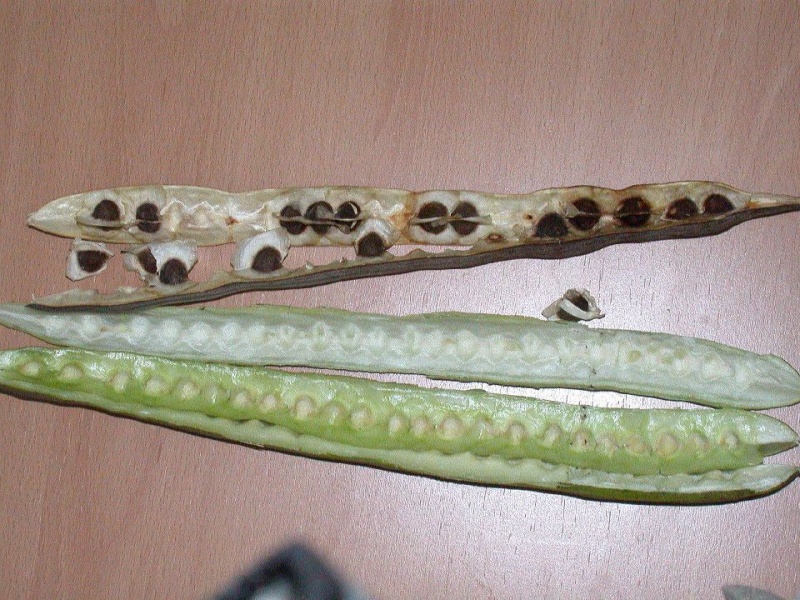
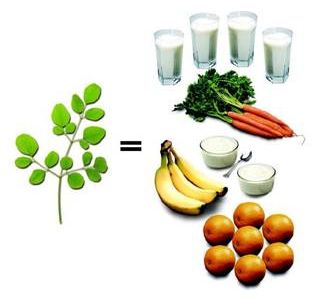






تعرف بالحبة الغالية/ الشجرة الكنز/ الشجرة المعجزة/ شجرة اليسار/الثوم البري/ فجل الحصان/ وعصا الطبلة.
اسمها العلميMoringa OLeifera وهي عبارة عن أشجار وشجيرات تنتمي إلى العائلة Moringaceae ومصدر الاسم يأتي من اللغة التاميلية. أما موطن الشجرة الأصلي فهو شمال الهند على سفوح جبال الهملايا.
كما تنتشر في باكستان, بنغلاديش وأفغانستان. هذا وتزرع الشجرة على نطاق واسع في العديد من المناطق المدارية والتي تشمل السودان وأثيوبيا والفلبين, كما انتشرت في أمريكا الجنوبية وجنوب أفريقيا.
استخدم قدماء الرومان والإغريق والمصريون شجرة المورينقا في العديد من الوصفات الطبية,
وتعتبر أشجار المورينقا من أنواع الأشجار متساقطة الأوراق, سريعة النمو, صغيرة إلى متوسطة الحجم, ارتفاعها من 7 أمتار – 15 متراً, ذات سيقان قائمة منتشرة القمة, ريشية الأوراق بيضاوية مقلوبة خضراء باهتة - ثمارها ذات قرون طويلة ومثلثة المقطع. تنمو الشجرة في الأراضي الطينية الخفيفة جيدة الصرف وتتحمل الجفاف بدرجة عالية - ولا تتحمل الشجرة الصقيع والجليد.
تتكاثر الشجرة بالبذور أو العقل و تحتوي بذور ها على 30% زيت, منه 65% حامض الأوليك . يستعمل الزيت في تشغيل الماكينات مثل زيت نبات الجاتروفا وهو غير سام ويستخدم في الطعام.
استخدامات المورينقا:-
- تستخدم الأجزاء المختلفة كغذاء للإنسان حيث تؤكل الأوراق والأفرع الصغيرة والقرون الصغيرة والأزهار والجذور.
وتعتبر الأوراق أكثر مايستهلك من الشجرة كغذاء حيث تحتوي على قليل من الزيوت والكاربوهيدرويتات وهي غنية بالمعادن والفايتمينات والأحماض الأمينية. كما تستهلك الأزهار والقرون مطبوخة . على صعيد آخر يمكن استهلاك البذور المطبوخة مثل البسلة. أما الجذور فيمكن استخدامها في الأكل بعد نزع قشرتها الخارجية لأنها تحتوي على مواد ضارة , كما يوصي بأن لايكثر الإنسان من تناول الجذور لنفس السبب.
- تصلح الأوراق والأفرع الصغيرة كغذاء لكل حيوانات المزرعة والدواجن ,خاصة إذا ماخلط بالبرسيم بنسبة 70% مورينقا و10% برسيم و20% أي علف آخر.
- تستخدم بدرة بذور المورينقا في تصفية الماء العكر بطريقة سريعة وفعالة وآمنة تضمن صفاء الماء وإزالة الكثير من الملوثات البكتيرية.
- تستخدم أوراق وأزهار وقرون وبذور شجرة المورينقا في العلاج البديل لعديد من الأمراض أهمها : سوء التغذية وقرحة المعدة والاسهالات كما تستخدم في علاج الالتهابات الجلدية البكتيرية والفطرية.
- هنالك العديد من الاستخدامات الأخرى منها: استخدامها كمبيد طبيعي لمكافحة مرض ذبول البادرات في المشتل وكسماد طبيعي . كما يستخدم غلف الأشجار في دباغة الجلود.



Family • Moringaceae
Malungay
Moringa oleifera Linn.
BEN OIL TREE
La mu
Other scientific names Common names
Moringa oleifera Linn. Arunggai (Pang.)
Moringa nux-ben Perr. Balungai (P. Bis.)
Moringa pterygosperma Gaertn. Dool (Bik.)
Guilandina moringa Linn. Kamalongan (P. Bis.)
Kalamungai (C. Bis.)
Kalungai (Bik., Bis., Tag.)
Kalunggay (Bik.)
Kamalungai (Pamp., Tag.)
Komkompilan (Ilk.)
Molongai (Tag.)
Malungay (Tag.)
Malunggue (Pamp.)
Malungit (Pamp., Bis.)
Maroñgoi (Sbl.)
Maruñgaai (Ilk., Ibn.)
Drumstick tree (Engl.)
Horse-radish tree (Engl.)
La mu (Chin.)
Ben oil tree (Engl.)
Botany
Malungai is a small tree growing as high as 9 meters, with a soft and white wood and corky and gummy bark. Leaves are alternate, usually thrice pinnate, 25 to 50 centimeters long. Each compound leaf contains 3-9 very thin leaflets dispersed on a compound (3 times pinnate) stalk. The leaflets are thin, ovate to elliptic, and 1 to 2 centimeters long. Flowers are white and fragrant, 1.5 to 2 centimeters long, on spreading panicles. Pod is 15 to 30 centimeters long, pendulous, three-angled, and nine-ribbled. Seeds are three-angled, and winged on the angles.
Distribution
• Planted throughout the Philippines in settled areas at low and medium altitudes.
• Introduced from Malaya or some other part of tropical Asia in prehistoric times.
• A common backyard vegetable and a border plant.
• Now pantropic.
Propagation
• Propagation by seeds and stem cuttings.
• Mature malunggay cuttings should be 2 cm or more in diameter and not less than 80 cm (30 inches) in length. Mature cuttings are preferred as they sprout earlier and grow faster.
• The only pests known to attack malunggay are mites of the Tetranychus spp.
Parts utilized
Flowers, leaves, young pods
Properties
• Root has the taste of horseradish.
• Considered galactagogue, rubefacient, antiscorbutic, diuretic, stimulant, purgative, antibiotic, antifungal.
• Antiinflammatory, antitumor activities on mice studies.
• Antioxidant, anti-aging, anti-ulcer.
• Estrogenic, antiprogestational, hypoglycemic, antihyperthyroidism, hypocholesterolemic, antihyperthyroid, antispasmodic.
• Considered abortifacient and emmenagogue.
• Purported to be beneficial for decreasing blood pressure, relieving headaches and migraines, reducing inflammatory and arthritic pains, anti-ulcer, anti-tumor. Purported to be beneficial for decreasing blood pressure, relieving headaches and migraines, reducing inflammatory and arthritic pains.
Constituents
• Root yields a essential oil, pungent and offensive in odor.
• Seed contains traces of an acrid and pungent alkaloid, Ben of Behen oil, whhich contains palmitic, stearic, myristic, oleic, and behenic acids, phytosterin; two alkaloids the mixture of which has the same action as epinephrine.
• Bark exudes a reddish gum with the properties of tragacanth, which is utilized for tanning.
• Gum yields bassorin, dextrin, enzyme myrosin and emulsin. The astringency of the gum is attributed to the presence of moringo-tannic acid
• Studies of MO leaves have yielded phytochemicals to which are attributed hypotensive effects and anti-cancer properties. The root bark has sex hormone-related properties.
• Root bark contains alkaloids, moringine which is similar to benzylamine, and moringinine; traces of essential oil, phytosterol, waxes and resins. Also contains a rich combination of zeatin, quercetin, beta-sitosterol, caffeoylquinic acid, pterygospermin and kaemferol.
Uses
Nutritional
• Flowers, young leaves and young pods eaten as a vegetable inn the Philippines, Malaya, and India.
• In Malaya, seeds also eaten as peanuts.
• Roots are used as seasoning because of it horseradish flavor.
• Young leaves are a rich source of calcium, iron, phosphorus and vitamins A, B and C.
• High in HDL (high density lipoproteins); a source of amino acids, omega oils, antioxidants.
• Young fruit yield a high amount of protein and phosphorus, a fair source of calcium and iron,
• Comparative content: Gram for gram, 7 times the vitamin C in oranges, 4 times the calcium and twice the protein in milk, 4 times the vitamin A in carrots, 3 times the potassium in bananas.
• 100 gms or 1 cup of cooked malunggay leaves contain 3.1 g protein, 0.6 g fiber, 96 mg calcium, 29 mg phosphorus, 1.7 mg iron, 2,820 mg beta-carotene, 0.07 mg thiamin, 0.14a mg riboflavin, 1.1 mg niacin, and 53 mg of vitamin C. (Dr. Lydia Marero of the Food and Drug Research Institute -FNRI)
Folkloric
- Decoction of leaves used for hiccups, asthma, gout, back pain, rheumatism, wounds and sores.
- Young leaves, usually boiled, used to increase the flow of breast milk.
- Pods for intestinal parasitism.
- Leaves and fruit used for constipation.
- Decoction of boiled roots used to wash sores and ulcers.
- Decoction of the bark used for excitement, restlessness.
- In India pounded roots used as poultice for inflammatory swelling. Flowers used for catarrh, with young leaves or young pods.
- In Nicaragua decoction of roots used for dropsy.
- Roots have been used as abortifacient. In India, bark is used as abortifacient.
- Decoction of root-bark used as fomentation to relieve spasms; also, for calculous affections.
- Gum, mixed with sesamum oil, used for relief of earaches. Same, also reported as abortifacient.
- In Java, gum used for intestinal complaints.
- Roots chewed and applied to snake bites.
- Decoction of roots is considered antiscorbutic; also used in delirious patients.
- Juice of roots is used for otalgia.
- Bark used as rubefacient remedy.
- Decoction of roots is use as gargle for hoarseness and sore throat.
- Leaves used as purgative.
- Chewing of leaves used in gonorrhea to increase urine flow.
- Fresh roots used as stimulant and diuretic.
- Seeds for hypertension, gout, asthma, hiccups, and as a diuretic.
- Rheumatic complaints: Decoction of seeds; or, powdered roasted seeds applied to affected area.
- Juice of the root with milk used for asthma, hiccups, gout, lumbago.
- Poultice of leaves applied for glandular swelling.
- Pounded fresh leaves mixed with coconut oil applied to wounds and cuts.
- The flowers boiled with soy milk thought to have aphrodisiac quality.
- Root is rubefacient and plaster applied externally as counterirritant.
- In West Bengal, India, roots taken by women, esp prostitutes, for permanent contraception (Studies have shown total inactivation or suppression of the reproductive system).
Others
• Dye: In Jamaica the wood is used for dyeing blue color.
• Oil: known as ben oil, extracted from flowers can be used as illuminant, ointment base, and absorbent in the enfleurage process of extracting volatile oils from flowers. |With ointments, the oil allows longer shelf life without undergoing oxidation.The oil, applied locally, has also been helpful for arthritic pains, rheumatic and gouty joints.
Breastfeeding women
• Malunggay leaves and pods are helpful in increasing breast milk in the breastfeeding months. One tablespoon of leaf powder provide 14% of the protein, 40% of the calcium, 23% of the iron and most of the vitamin A needs of a child aged one to three. Six tablespoons of leaf powder will provide nearly all of the woman's daily iron and calcium needs during pregnancy and breastfeeding.
Studies
• Moringa preparations have been cited often in scientific literature as antibiotic, antiinflammatory, hypocholesterolemic and hypoglycemic. However, many of the reports are not placebo-controlled randomized clinical trials.
• Anti-Inflammatory / Anti-tumor: Anti-inflammtory and Antitumor Activities of Seeds Extracts of Malunggay—A study showed the crude ethanol extract of dried seeds inhibited the carrageenan-induced inflammation in the hind paw of mice by 85% at a dosage of 3 mg/g body weight; the mature green seeds by 77%. The crude ethanol extract also inhibited the formation of Epstein-Barr virus-early antigen (EBV-EA) induced by 12-0-tetradecanoylphorbol-13-acetate (TPA). At a dosage of 100 ?g/ml, the extract inhibited EBV-EA formation by 100% suggesting its antitumor-promoting activity.
• Ovarian Cancer: Possible Role of Moringa oleifera Lam. Root in Epithelial Ovarian Cancer: A hormonal etiology of epithelial ovarian cancer has been long suspected. Study suggests M Oleifera can interfere with hormone receptor-related and neoplastic growth-related cytokine pathways through centrally acting mechanisms.
• Asthma: Antiasthmatic activity of Moringa oleifera Lam: A clinical study: Study showed improvement in forced vital capacity, FEV1, and peak expiratory flow rate. It suggests a usefulness for MO seed kernel in patients with asthma.
• Antibiotic: 50 years ago, a study yielded Pterygospermin, a compound that readily dissociates into two molecules of benzyl isothiocyanate which has been shown to have antimicrobial properties. Unfortunately, many of the reports of antibiotic efficacy in humans were not from placebo controlled, randomized clinical trials. Recent studies have demonstrated possible efficacy against H. pylori.
• Hormonal properties / Abortifacient: Biochemical observations and histologic findings have been correlated with the anti-implantation action of aequous extracts, one possible explanation for its use as an abortifacient. source
• Antiurolithiatic: Study showed lowering of stone forming constituents in the kidneys of calculogenic rats with the use of aqueous and alcoholic extracts of MO suggesting antiurolithiatic activity.
• Antimicrobial / Water Purifyiing: Study of MO seeds paste for water purification yielded a steroidal glycoside, strophantidin, a bioactive agent in the seed. The seed paste was found effective in clarification and sedimentation of inorganic and organic matter in raw water, reducing total microbial and coliform counts by 55% and 65% respectively, in 24 hours, compared to alum with 65% and 83% reduction.
• Antipyretic / Wound Healing: Study of the ethanolic and ethyl acetate extracts of MO showed significant antipyretic activity in rats; the ethyl acetate extract of dried leaves showed significant wound healing on rat wound models.
• Analgeic: Previous studies have shown analgesic activity from the leaves of MO. This study on the alcoholic extract of MO seeds showed potent analgesic activity comparable to that of aspirin dose of 25 mg/kg BW.
• Hepatoprotective / Antioxidant: Study concluded that the alcoholic extracts of MO produced significant hepatoprotective and antioxidant activity, the aqueous extracts of the fruit less than the alcoholic extract.
• Anti-Ulcer: Study of M oleifera extract showed ulcer by protection by modulating 5-HT secretion through EC dell via 5-HT3 receptors in the gastrointestinal tract.
• Anthelmintic: In a comparative study of the anthelmintic activity of M oleifera and V negundo against Indian earthworm Pheritima posthuma, dose-dependent activity was observed with M oleifera showing more activity than V negundo.
• Comparison with Atenolol: Study comparing the effects of M oleifera with atenolol in adrenaline-induced rats on serum cholesterol, triglycerides, glucose level, heart and body weight showed the M oleifera leave extract made significant changes in each cardiovascular parameter.
• Hepatoprotective: Study in acetaminophen-induced liver disease in mice showed that leaves of MO can prevent hepatic injuries by preventing the decline of glutathione level.
• Antioxidant / Hypolipidemic / Anti-Atherosclerotic: Study showed lowering of cholesterol levels and reduction of the atherosclerotic plaque formation. Results indicate MO possesses antioxidant, hypolipidemic and antiatherosclerotic activities and has therapeutic potential for the prevention of cardiovascular diseases.
• Chemomodulatory / Chemopreventive: Study showed the possible chemopreventive potential of Moringal oleifera against chemical carcinogenesis.
• Anti-Diabetic: Study of the aqueous extract of MO leaves in STZ-induced sub, mild, and severely diabetic rats produced lowering of blood glucose levels, significant reduction in urine sugar and urine protein levels. Study validates scientifically claims on MO as ethnomedicine in the treatment of diabetes mellitus.
In the news
• In Leyte, extracted malunggay juice is mixed with lemonsito juice to make ice candies or cold drinks, making it more plalatble and agreeable to children who detest vegetables.
Because of its high vitamin A, C, and E content, all potent antioxidants, malunggay is a very effective in removing unstable free radicals that is damaging to molecules and pro-aging.
For the men: The fruit could increase the sperm count !
For increasing breast milk: One rounded tablespoon of leaf powder provides 14% of protein requirements, 40% of calcium, 23% of iron, and the daily vitamin A needs of a child aged one to three. Six rounded tablespoons of leaf powder will provide the woman's daily iron and calcium needs during pregnancy and breast-feeding.
Recent uses and preparation:
Constipation: Eat one or two cups of the cooked leaves at supper time, with plenty of water.
Wound wash: Apply crushed leaves directly to the wound, maintaining cleanliness duriing the process.
• Biofuel source
• Moringa oil extracted from the seed of the malunggay plant is now being tapped as source of biodiesel. It is gaining preferable status over Jatropha as a source of biofuel. All parts of the malunggay plant are used whereas Jatropha is left with poisonous waste after oil extraction. Also, malunggay needs only one to two years for seedling maturation compared to Jatropha's three to five years. The math of malunggay's commercial potential is attractive: Seeds are bought at P10 per kilo, and a hectare of malunggay seedlings can harvest 20,000 kilos in 2 years with a potential profit of P200,000. (Philippine Star)
Toxicities
ª Root bark contains 2 alkaloids, as well as the toxic hypotensive moringinine.
ª Has dose-dependent negative inotropic effect, in isolated frog heart study.
• Niazinin A, niazimicin and niaziminin A and B isolated from the ethanol extract produced hypotensive, bradycardic and negative inotropic effects in experimental animals.
• The bark may cause violent uterine contractions that can be fatal. Chronic high-dose use may cause liver and kidney dysfunctions.
• In frequent or large doses, Interior flesh of the plant can cause toxic nerve paralysis from the alkaloid spirochin. source
Supertitions
Malunggay ingestion is avoided in the immediate period after a family member's death. In the superstitions-laden isms of rural Tagalog life, as a malunggay branch or twig will shed off all its leaves within a few hours of being snapped off a tree, ingesting malunggay might bring death to a relative. Avoiding its use is strongly advised during the ritual of nine days of prayers after a death.
Availability
Wild-crafted.
Garden and back-yard cultivation.
Commercial production of oil extracted from flowers.
Malunggay capsule (Natalac) - containing 250 mg dried young malunggay leaves, one to two capsules daily.
Miracle tree products in the cybermarkets.














 مواضيع مماثلة
مواضيع مماثلة» شجرة المورينقا (( الروّاق)) Moringa OLeifera
» شجرة العُشَر
» شجرة الثُدَّاء
» شجرة الزقوم فى القرآن
» زيت الأرغان .... الأرجان ... أرغان: شجرة الحياة المغربية
» شجرة العُشَر
» شجرة الثُدَّاء
» شجرة الزقوم فى القرآن
» زيت الأرغان .... الأرجان ... أرغان: شجرة الحياة المغربية
صفحة 1 من اصل 1
صلاحيات هذا المنتدى:
لاتستطيع الرد على المواضيع في هذا المنتدى
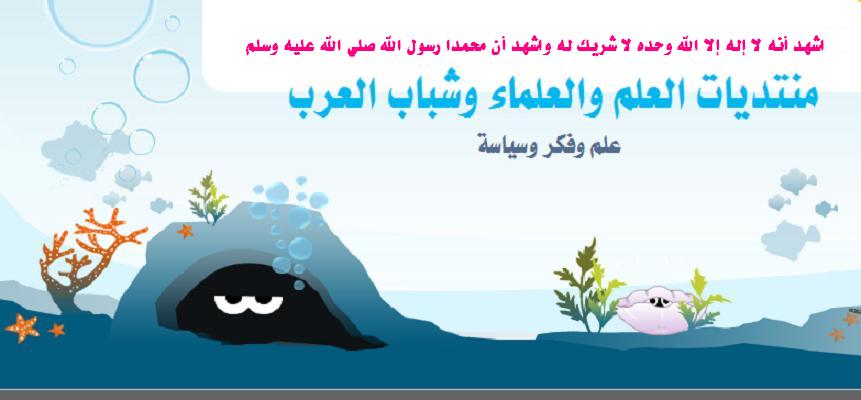
 البوابة
البوابة أحدث الصور
أحدث الصور
